

What sets a great manager apart from the rest? That’s what the protagonist of The One Minute Manager is trying to figure out.
Once he stumbles upon the titular one minute manager, he realizes that it’s possible to have it all—outstanding results, productive and satisfied employees, and work-life balance. He picks the manager’s brain to learn how to accomplish this holy trinity of managerial excellence, and that’s what forms the backbone of this book. ⏱️
Written in 1982 by Ken Blanchard and Spencer Johnson, this short fictional story reveals the tested techniques of exceptional leaders, emphasizing how to make the most of your team with minimal directives.
If you’re pressed for time, read our The One Minute Manager summary and discover its main takeaways. Stick to the end, and we’ll also explore how to apply these principles within ClickUp, a free project management solution that helps you go hand-in-hand with the book’s philosophy.
💡📚 Bonus: But before that, if you want to read more books like this, check out our curated collection of 25 Must-Read Productivity Book Summaries (including this) in one place. You can save, edit, bookmark, and even export it.

The One Minute Manager Book Summary at a Glance

Let’s start at the very beginning: The story of the One Minute Manager introduces us to a young man on a path to finding an effective manager and learning from them. Most managers he knew were either strictly result-oriented or would just manage people. His goal was to track an individual who balances both these aspects and, more importantly, is willing to share the knowledge.
After stumbling upon a manager who might fit this description, he pays him a visit. At first, the young man was dumbfounded by the manager’s noticeably odd demeanor and practices. For instance, the manager seemed serious and rarely even spoke to his employees. Still, he was able to keep them content and achieve consistently positive results. 🤔
This seemed like an unnatural management style to the young man. It was only later, after speaking to three of the manager’s employees, that the man understood why they call him the One Minute Manager—and what makes him tick.
Each of the employees shared a crucial secret of the One Minute Manager, forming the crux of the book. Let’s break down the three secrets—deemed as the three techniques of effective management—below:
1. One Minute Goals
The first staff member the young man spoke to was Mr. Trenell. He revealed that the manager always makes sure everyone’s on the same page when it comes to responsibilities. 📖
After the manager and the employee agree on what needs to be done, the latter is tasked with writing down the goals. Each goal takes up a total of one page and includes no more than 250 words, requiring only a minute of reading.
To determine priorities for this one minute goal setting, the employees and the manager use the 80–20 rule or the Pareto Principle, which suggests that 80% of results stem from 20% of the team input. The aim is to focus on the 20%, usually resulting in fewer high-value goals over a disorganized array of tasks.
One minute goals work because the manager also sets clear standards for measuring employee performance. This leaves no room for uncertainty and enables every staff member to assess their output throughout the day.
2. One Minute Praisings
Our next employee is Mr. Levy. He shared that the manager closely observes anyone with a new job at the company. The idea is not to micromanage staff members but to allow the manager to catch them doing something right and praise them immediately.
No one has to waste time talking—the one-minute praise is concise and efficient. The manager:
- Takes a few moments to offer specific details about what the employee excelled at
- Shares positive feedback on how the action offers a lasting benefit to the company
- Takes a slight pause to let the compliment sink—to avoid sounding robotic or insincere
- Ends the praise by encouraging the employee to keep up the good work
On the opposite end of the spectrum, a regular manager would just wait for the annual performance review to share positive feedback. This isn’t as effective because the employee may forget all about the action that needs to be reinforced. 😅
3. One Minute Reprimands
The final person the man spoke with was Ms. Brown, who told him about the importance of proper one minute reprimands. Much of the advice about one minute praisings also applies in this case.
For example, the employee is aware that the manager will track their progress and offer regular feedback. With the consequences established upfront, the manager reprimands negative behavior immediately upon noticing it. He is specific about what went wrong and how he feels about it, giving the staff member a good understanding of where he’s coming from.
In the second half of the one minute reprimand, the manager makes sure the encounter ends on a positive note. He lets the employee know that he values their work even if they don’t perform at 100% all the time. Ideally, both parties understand the undertones and can laugh about it by the end of the conversation. 😄
Note: To soften the tone, the concept of One Minute Reprimands has been switched to One Minute Redirect in the later editions of the book, now called The New One Minute Manager.
Key Takeaways: The One Minute Manager by Ken Blanchard and Spencer Johnson
Through its creative use of allegories and relatable story-like narrative, the book One Minute Manager provides many pearls of managerial wisdom, all science-backed and applicable in many situations. 🦉
Let’s read about some of the most notable tips provided in the book:
1. Use clear language
The book frequently uses the phrase in no uncertain terms when describing how managers should communicate with employees, whether instructing, praising, or reprimanding them.
According to the book, the manager should never make assumptions about what employees know. They should present the information in transparent language to facilitate comprehension. That way, employees can define clear goals for themselves and work with greater precision and confidence.
2. Ensure your behavior matches your words
Most of us have encountered at least one manager who is a tough nut to crack. They’re always in hustle mode with no time for vulnerability or emotions, even when the team is not in a great mental space.
The One Minute Manager recommends the opposite—an effective manager is honest about their feelings and intentions. This is the leader who instills trust and security among employees instead of manipulating or lying to them to meet an end.
Because of the genuine approach, team members are much more motivated to contribute to the goals. They even follow suit and strive to be authentic in their communication.
3. Separate undesirable behavior from the person
The manager in the book repeatedly emphasizes that when providing negative feedback to employees, the focus should be on pinpointing the specific behavior, not demanding their individual worth. The goal is to eliminate the unproductive or negative behavior, not the person.
For the same reason, the one minute manager shares kind words after reprimanding the employee to let them know their efforts are appreciated. When he finishes his review of the employee’s performance, he moves on, trusting the employee’s ability to take accountability for the setback and bounce back from the situation. 🏀
4. Facilitate independence
The manager in the book calls out leaders who assume employees know what they’re doing and leave them to their own devices, only to rebuke them later when something goes wrong. While managers shouldn’t micromanage staff members, they must train their workers or offer instructions if they want to see them succeed independently.
To demonstrate how to do this, the one minute manager evokes a well-known psychological concept—shaping. Instead of expecting the employee to complete a task perfectly right away, the manager conditions them to identify desirable and undesirable behavior.
Over time, the employee can complete and even review the task on their own, reducing the need for excessive managerial supervision.
5. Treat everyone like a potential winner
The world tends to label individuals as winners and losers. Typically, managers only want to hire “winners” as they think such individuals are more likely to contribute positively to the company’s goals. According to the One Minute Manager—it is a limiting and pointless approach.
The one minute manager believes that everyone can be a winner if given the chance. While it’s natural to categorize, we mustn’t let this tendency deem us inefficient, especially while hiring. Instead of wasting time looking for the perfect candidate, the manager should invest in training the employees and help them all become winning team players. 🏆
6. Make people feel good
If the work environment is hostile, with too many incidents of the manager disrespecting them, employees feel anxious and unappreciated, and productivity is the last thing on their minds. But one of the standout achievements of the one minute manager is that his employees seem to be happy at work.
Well, a good manager makes their employees feel good. They genuinely care for their well-being and treat them with kindness. That can look like:
- Respecting their work style and boundaries
- Listening to their concerns
- Sharing kind words regardless of performance
Leaders who manage people with care are able to achieve seamless workplace collaboration and attract favorable results. 💗
7. Share knowledge
In the book, each of the three employees the young man spoke with said they’re becoming one minute managers themselves. Spoilers ahead: In the end, the protagonist also embraces the one minute management style—and writes a book to pass on the wisdom to the collective.
This part of the book teaches us the importance of spreading knowledge to achieve common goals. By helping his employees adopt his management style, the manager was able to streamline operations and save his team a lot of time and effort.
With more time and energy on their hands, the employees reduced their physical and emotional stress levels and became more secure. Problems such as absenteeism and high turnover were reduced greatly as well.
💡📚 Enjoying reading this? You’ll also love our curated collection of 25 Must-Read Productivity Book Summaries. You can save, edit, bookmark, and even export it.
The One Minute Manager: Popular Quotes
Here are three quotes from The One Minute Manager that we found particularly impactful.
Feedback is the breakfast of champions.
The One Minute Manager believes positive feedback is the number one motivator of people. Like breakfast provides fuel to start our day, feedback helps us take a look at our performance and powers initiatives to learn, adapt, and become better at what we do. 🍳
We are not just our behavior, we are the person managing our behavior.
Managers must ensure their behavior matches their goals. For example, even if you catch unproductive employees at work, your reaction shouldn’t be anger-driven but rooted in the fact that you want to foster a harmonious and growth-oriented workplace. 🌱
Goals begin behaviors, consequences maintain behaviors.
This quote, which the young man coined at the end, sums up the One Minute Manager’s whole philosophy. When employees set a goal, they’ve also set the right direction for where they want to go. And with proper praisings and reprimands, they can stay on track and learn how to get to the end point faster. 🏎️
Apply The One Minute Manager Principles and Learnings with ClickUp
Translating the three techniques of the One Minute Manager from theory to practice isn’t always easy because it’s easy to get overwhelmed by workplace uncertainties and fears. For example, how do we make a team feel safe when we’re hit with a major setback?
That’s exactly why you need project management tools like ClickUp. The software comes with management-focused features that allow you to streamline and monitor operations and have a bigger picture of your goals at all times. Its built-in productivity and communication features help you and your team save time, keep deadlines, and meet challenges with full transparency and confidence.🌹
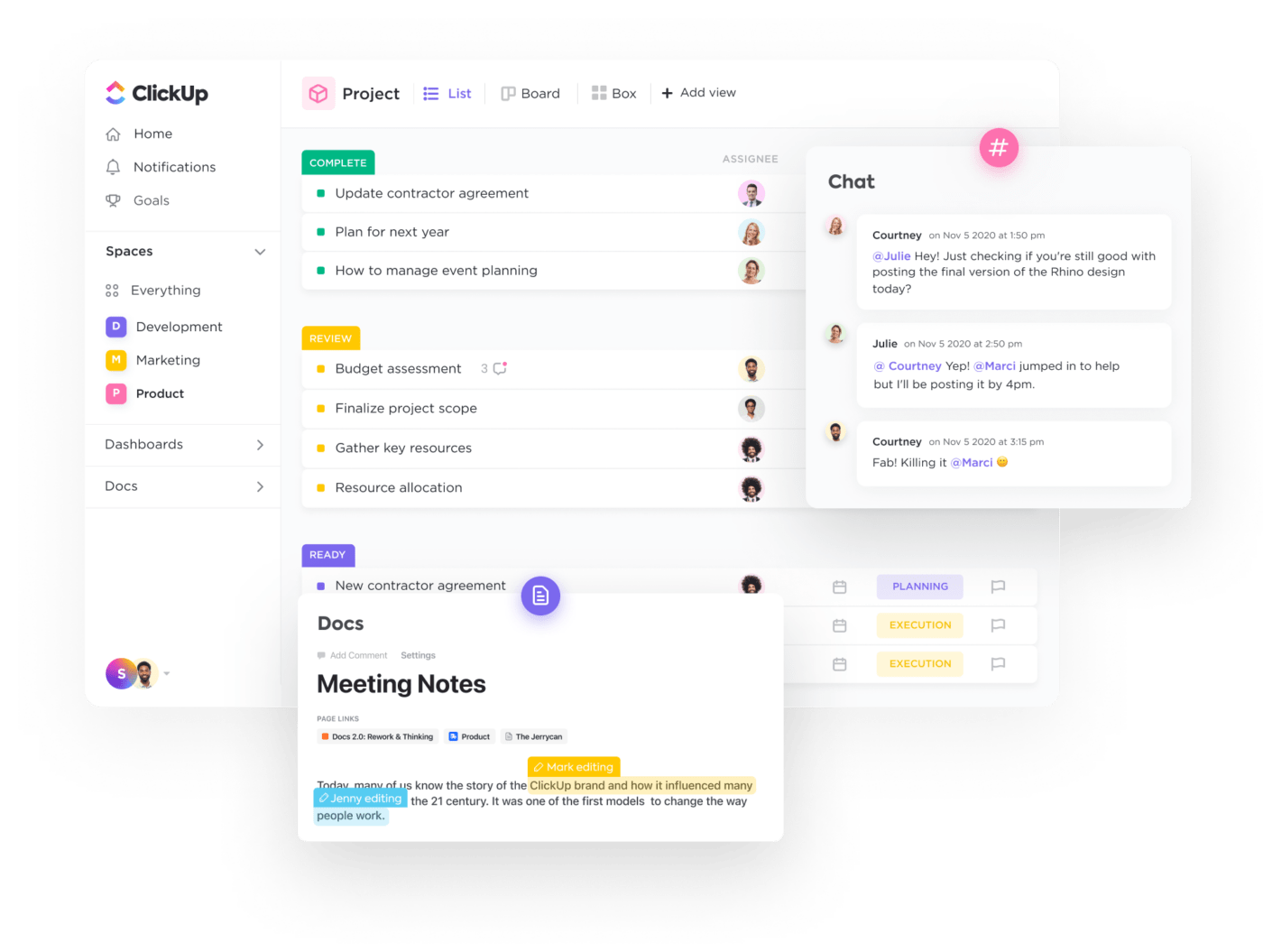
If the one minute manager had ClickUp at his disposal back in the 80s, could his title have been the Half-Minute Manager? Maybe! 😊
Let’s explore some of ClickUp’s top functionalities that’ll help you implement The One Minute Manager’s principles.
Centralize your knowledge base and define expectations with ClickUp Docs
ClickUp Docs allows you to create an all-in-one Workspace where each staff member can get informed about the company, project portfolio, roles, and SOPs. Instead of endless note-taking and back-and-forth emailing with the manager, employees look up anything work-related, be it tasks or documents, with a Universal Search feature.
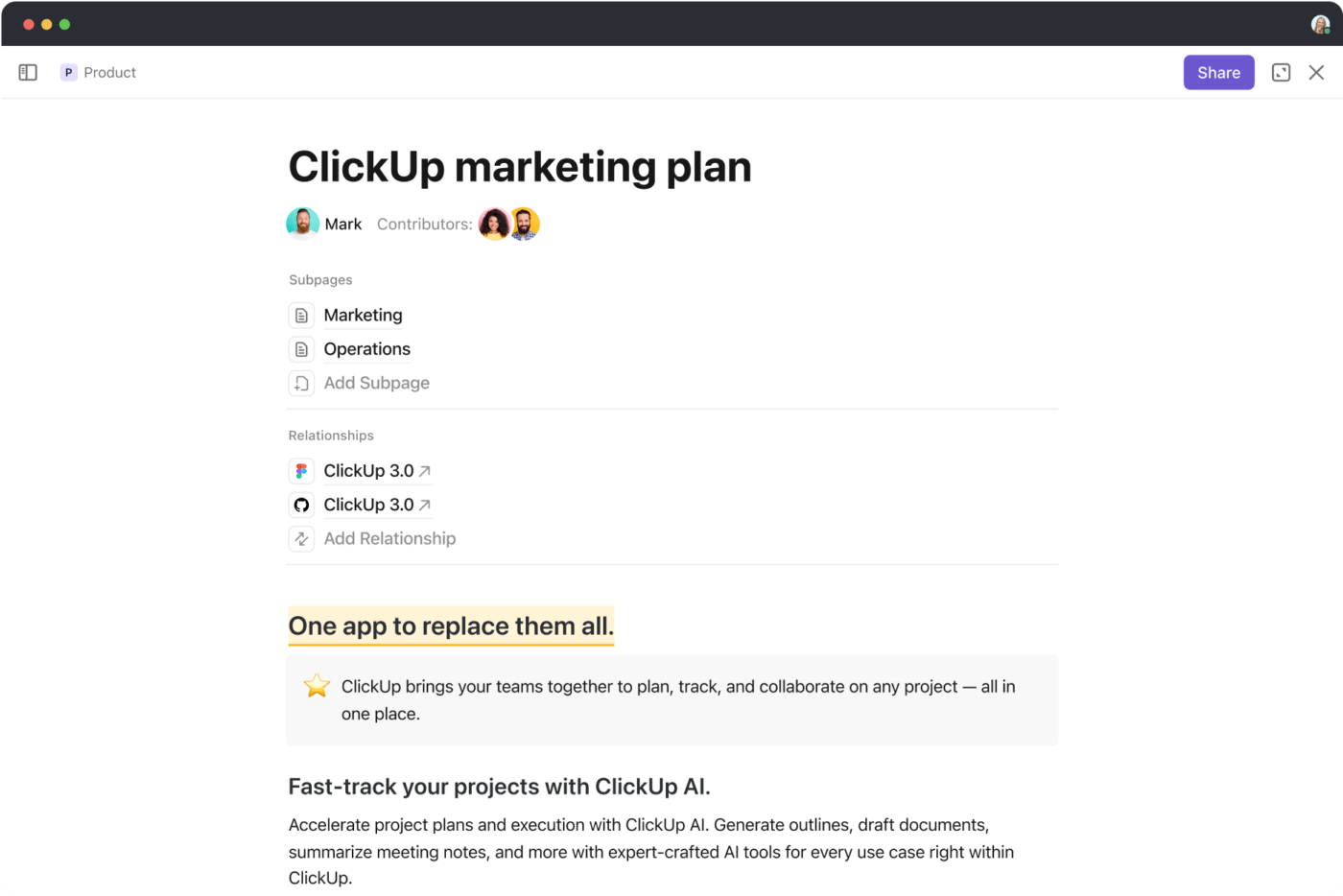
As a manager, you can fast-track your tasks by using ClickUp AI. This native AI assistant gives you dozens of role-specific prompts for generating employee-facing documents and polishing existing ones for tone and clarity. Your teammates can also leverage the AI tool to summarize texts and extract action items.
Make your employees’ schedules clearer by creating tasks within ClickUp—divide their workflows into more manageable subtasks and daily checklists and add assignees, instructions, tags, and priority labels. By clicking on a task, the employee can access the fully customized Task view and gather all the information they need for execution.
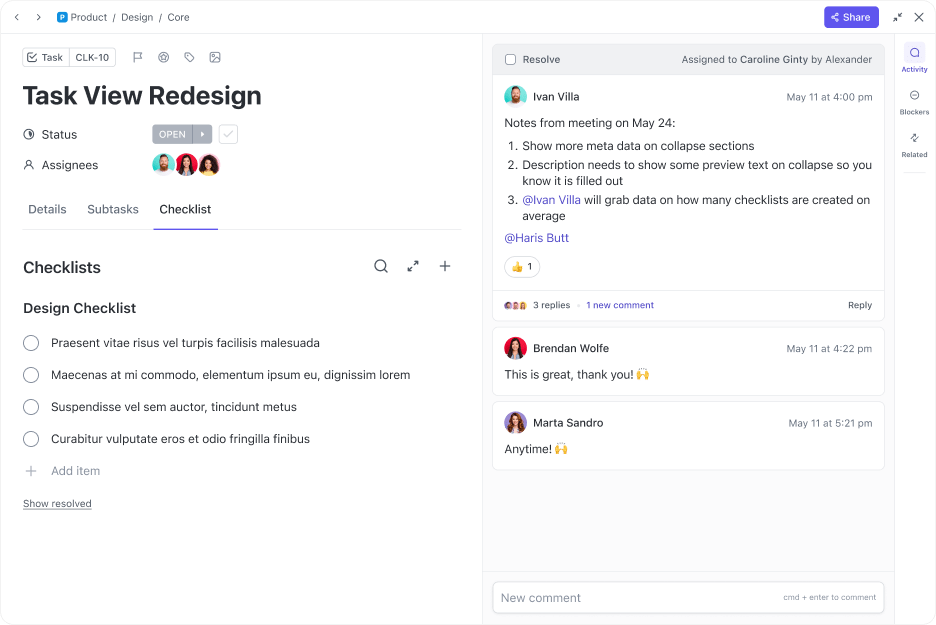
That’s not all—thanks to ClickUp Automations, you can spend less time on task management by automating administrative actions like changing task statuses or sending emails. You can also jump on numerous views for different managerial actions, such as
- Tracking phase-wise progress of tasks with the classic Board view
- Checking overworked or underutilized team members on the Workload view
- Scheduling projects using the Gantt Chart view
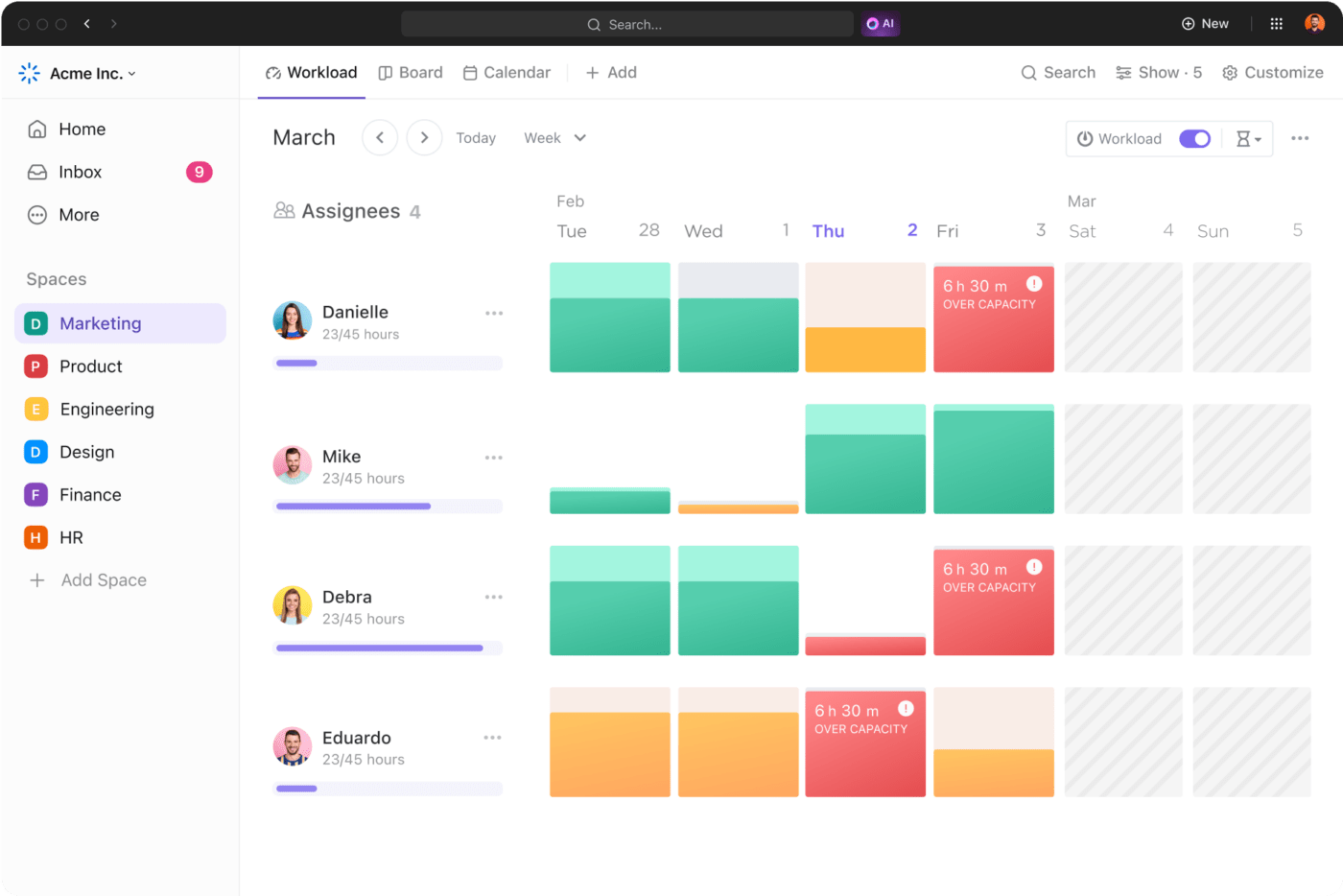
Set goals and track progress without micromanaging
Looking to improve your one minute goal setting processes? With ClickUp Goals, both managers and employees can define their objectives and break them down into smaller targets that are easier to review and measure.
Organize goals into folders based on what different teams in your organization are working on independently. ClickUp can track your progress automatically, displaying all percentages in one place so you can always see where you’re at.
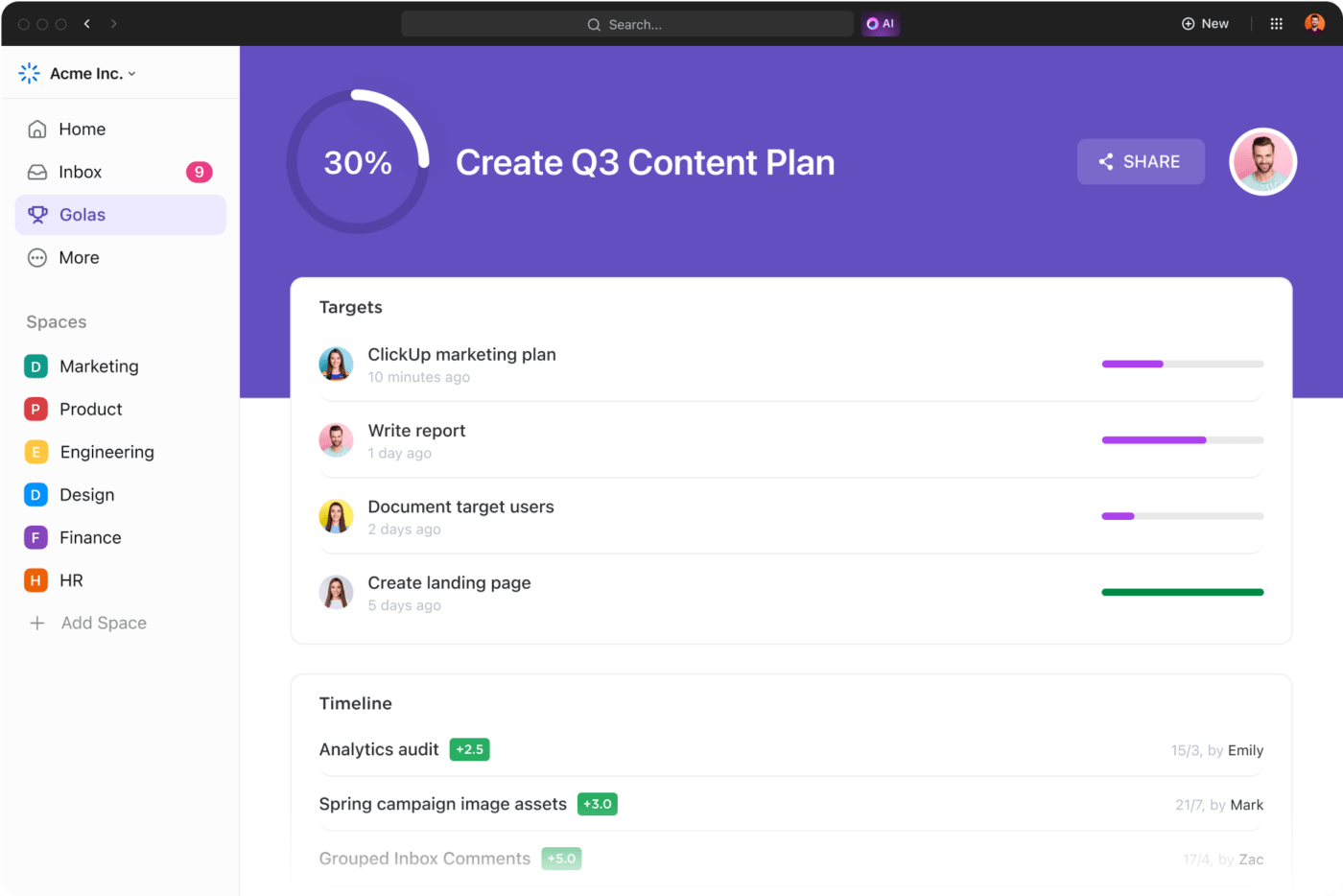
You can also build a ClickUp Dashboard using one of the 50+ available cards and create a visual overview of your team’s work and performance in real time. This lets you quickly identify strengths and bottlenecks and offer immediate and effective praisings and redirects.
When you know what’s working, it’s easy to standardize processes and optimize workflows with greater precision. With ClickUp’s native reporting tools, you can even plan remedial measures based on data-backed reports and keep your team relatively stable during tough times.
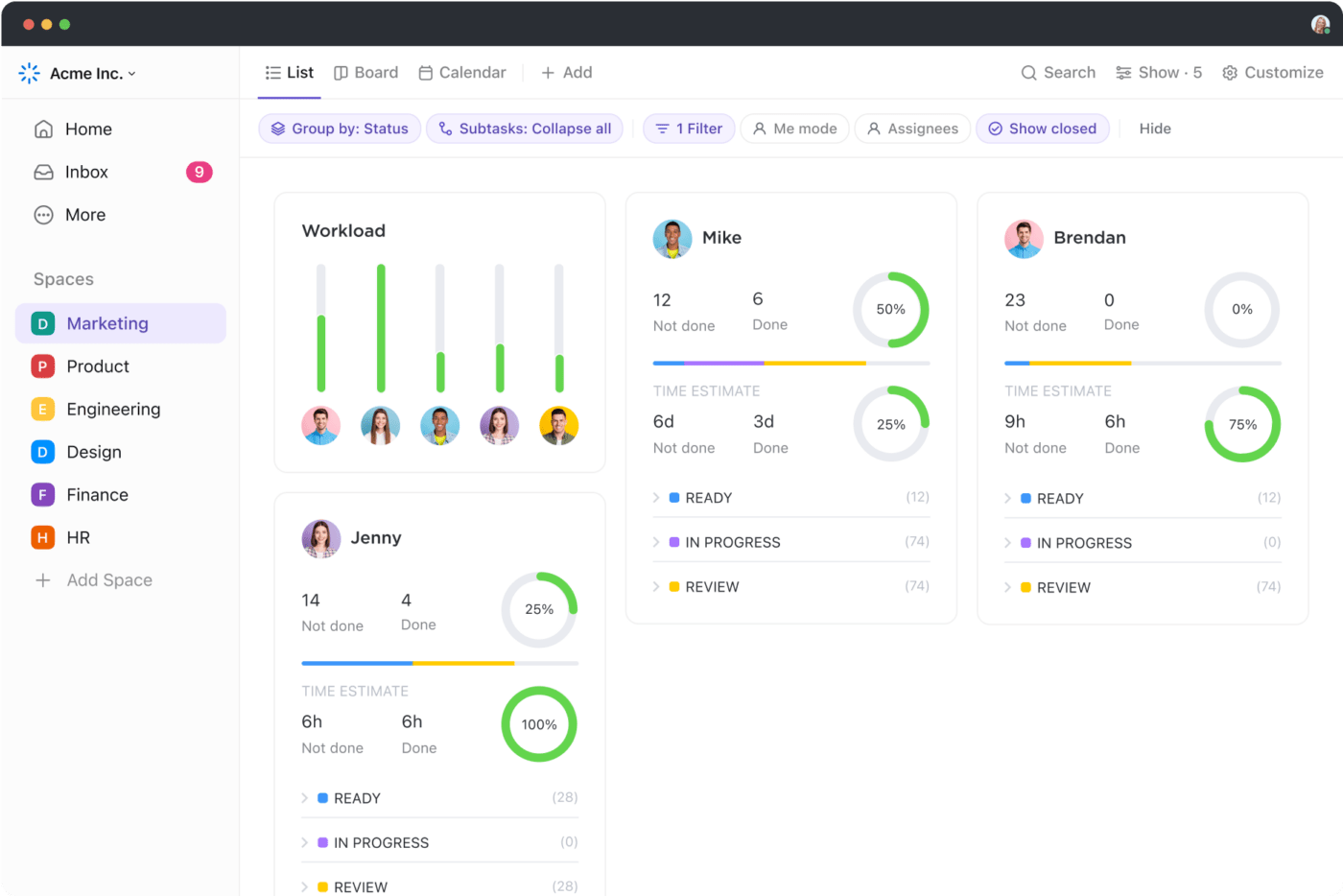
Offer meaningful feedback and collaborate productively
The one minute manager would probably love ClickUp’s ability to streamline communications. The platform offers all the features you need to run healthy feedback loops within your company.
As a manager, you can use comments to review tasks and proof documents or other files. For a more direct and personal discussion, you can leverage the ClickUp Chat view to share one minute redirects or praises in a more relaxed space.

We personally love @mentions in ClickUp for quick positive behavior reinforcements that otherwise tend to get ignored in the annual performance review, especially for remote teams.

Show your team you value their opinion as a leader during efficient brainstorming sessions. Besides efficient feedback sharing, ClickUp also serves as a one-stop collaboration platform, thanks to tools like Whiteboards and Mind Maps, where you can analyze processes, discuss campaigns, and work on new ideas.
Bonus: Explore the ClickUp Template Gallery to download readymade manager-friendly templates.
Master One Minute Management Style with ClickUp
Book summaries pique our interest, but we’d always recommend giving the main book a full read. The One Minute Manager is only 110+ pages and shouldn’t take more than a few hours to finish!
This book offers handy tips for all leaders, helping them become more time-efficient without compromising on results or job satisfaction. And with a comprehensive project management tool such as ClickUp, these valuable concepts are easier to apply. Sign up today and set you and your team up for growth! 🌾




